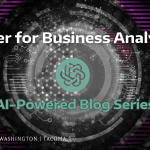This article is a guest contribution by Wing Yew Lum. The views and opinions expressed in this article are solely those of the author and do not necessarily reflect the official policy or position of the AI Hub. We’re thrilled to feature diverse perspectives on our platform.

Part 1: Letters from the Field – To Emerging Leaders in Analytics (From Data Analysts to Data Scientists and Beyond)
A little context. The authors of this series of letters are proud University of Washington alumni. The education we received prepared us for a range of data intensive organizations in a variety of economic environments. We’ve worked at bootstrapped startups as well as venture funded ones. We’ve served at vertical focused technology companies (like Expedia) as well as cross-vertical, mega-cap juggernauts (like Amazon).
Our current company (storytellers.ai) is a technology consultancy focused on democratizing data science and machine learning for companies in every vertical. We serve everyone from analysts and operators in higher education and local government to executives in supply chains and online retail. As individuals, we’ve been entry level analysts and general managers as well as founders overseeing analytics, engineering, product, science, and user design.
Setting the Stage
While privileged to serve past and current students in traditional ways (like teaching), we think this invitation from Professor Davalos – to write candid letters to students preparing for success in analytical careers – is an exceptional privilege for transparency and hopefully value creation.
We’ll do one mental framework per letter and here’s the first – a paradigm to help maximize your clarity and resonance with stakeholders, gain incremental trust quickly, and attract likeminded operators to partner with over the long term.
Begin with Mental Models, Conclude with Specificity and Action
Mental models and principles are explicit, hopefully easily understood, representations of how we believe the world works (or at least, how we perceive the world to work). They are both your problem solving frameworks and the underlying principles for how you operate.
You’ve already encountered dozens of domain specific mental models as an analytics leader. Some that might appear familiar: garbage in and garbage out, mutually exclusive and collectively exhaustive (MECE), separation of concerns, persistent and immutable staging areas, Pareto principle, minimum viable product, unhelpful accuracy, and more.
By using mental models, we show partners – leaders, peers, direct reports alike – how we think about the world (and how our subsequent actions should logically follow from those beliefs). And even when your mental model is flawed (imprecise, illogical, non-comprehensive, etc.), by sharing your mental model early, you expose your principles and worldview which then invites others to rapidly (and clearly) iterate with you.
Specificity and Action: Where Credibility Takes Root
Specificity and action are where your credibility will be established after your mental model for problem solving is heard and confirmed (or debated!). Specificity, well communicated, will do what your mental model does but at the level of your situation – it provides a set of deep, situational context that can establish the facts of the work at hand, your analysis of the facts, and eventually, your recommendations (including the actions that you and your team will take on).
Action is the result of combining effort with your mental model in the specific context you’re operating in. It is where philosophy and review has an impact.
Hypothetical Action Unveiled
Below, you’ll find a simple example of this mental model in action. As a reminder, this framework applies whether you’re presenting a new attribution dashboard you built atop a data warehouse you just constructed… or you’re building a next generation recommendation system or even delivering an unsupervised machine learning model to aid with customer segmentation.
All analytical presentations (and many non-analytical presentations) can make use of this mental model.
The show begins: You have an analytical update to provide to the VP of Analytics, VP of Data Science, as well as the VP of Marketing. You and your team spent months preparing a new deliverable – a segmentation analysis – that they jointly asked for last quarter. All three leaders, along with their teams, have contributed to the vision and requirements, but you and your team were responsible for the delivery.
As you enter the room, there are two dozen science, product, and engineering leaders on one side and another half dozen marketing leaders on the other. You take a deep breath and begin.
“Let me provide a few moments of brief context by stating our mental model for this work. One of our pillars as an analytical team is that we create value through context and empathy. The better and more accurately that we can understand the needs and wants of our customers, the smarter and more effectively we serve them.
Inline, success in this segmentation analysis hinges on: (1) its ability to accurately and incrementally reflect our customer groups, and (2) our ability to take actions which benefit our customer groups.
If this sounds right, I’d like to briefly highlight the steps we’ve taken, and will take, to positively serve our customer base.”
“First, we’ll describe the data sources used during our analysis – what we included and excluded (and why!).
Second, we’ll discuss feature selection and engineering alongside how we handled missing or problematic data.
Third, we’ll describe which unsupervised models we used and how we evaluated our model (including reviews with members of this operational team).
Fourth, we’ll review the deliverable – including the suggested segmentations and look forward to hearing your feedback.”
The Power of Contextual Communication
Leadership thanks you for your context. They also ask to hear who all worked on this initiative from the joint teams, including who ultimately reviewed and approved the final segmentation recommendations. You acknowledge that ask as valuable, make a note to include it in your update, and proceed.
Conclusion: Charting Your Analytical Course
We hope this first piece of guidance creates value for you. If you have any questions or concerns about this mental model or example, please reach out to us at hello@storytellers.ai. We’re glad to help you unpack further. Also, we’re always trying to recruit the next great data scientist, software engineer, or machine learning specialist – reach out if you’re interested!
About Us: Pioneering Data Science at Storytellers.ai
Storytellers.ai is a Seattle-based data science and generative AI-focused machine learning consultancy. They provide end-to-end data science solutions via a patent-pending platform and a world class (industry experience) implementation team. Their clients range from public financial institutions to global NGOs to local governmental agencies and top tier universities.






